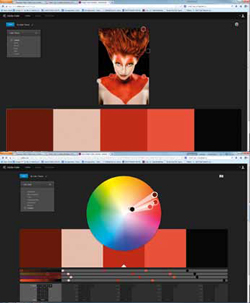articles/Software/Adobe-Creative-Cloud-page6
Adobe Creative Cloud - part 6 of 1 2 3 4 5 6 7
by Mike McNamee Published 01/02/2014

Illustrator CC
There are only a couple of new filters in the very mature Illustrator line-up. Of these, the new transform tool enables the distortion of vector artwork to exactly fit the shape within a photograph when it is distorted by perspective. It is possible to envisage plenty of uses for retouch and livery tests if you have new corporate logos and wish to see how they might look.
The improvements in Kuler are very welcome as it is a utility we use in almost every issue of Imagemaker to both devise and refine colour swatch sets for use in designing features. For any readers unfamiliar with Kuler it is the go-to method for making a set of colours against a number of colour wheel 'rules' (eg Harmony, Complementary, Analogous) or from a source image (a JPEG file). The generated colour set may then be saved as a theme and downloaded for sharing with colleagues and/or transfer to InDesign for page-design use.

Kuler remains the best method of creating harmonised colours from either an image or for a theme. It is RGB based and so you always have to check out the final colours if they are to be used in a cmyk workflow.
Lightroom 5Lightroom is not technically part of Creative Cloud and does not carry the CC tag. It has, however, been upgraded to version 5 during 2013 with quite a lot of new features. These include:
- Radial Filter
- Enhanced Spot Removal tool
- Upright - Automatic Perspective Correction
- Smart Previews
- Improved Book Creation
- Share Photos with Publishing Services
- Videos in Slideshows
- Lab Color Values Readout
- Loupe Overlay: Grid
- Loupe Overlay: Guides
- Support for PNG files
- True full-screen mode
It is the improvements in functionality which appears to be driving people towards being 'Lightroom only' users of Adobe products - they are finding that it does all they require.
However, if you wish to interface output from Lightroom with Photoshop or a press workflow there are a few things you need to be alert to. By default, the Lightroom preferences are something of a mess! In a nutshell, a compressed, 16-bit, ProPhoto RGB file at 240ppi resolution contains not a single parameter that is friendly towards a press workflow. A better option would be an 8-bit uncompressed TIFF in Adobe RGB at 300ppi. It is also worth stating at this point that you should expect a printed output from Photoshop and Lightroom to be IDENTICAL. If they are not, look to either your printer settings, preferences or both. This topic is cropping up regularly at Epson Print Academy seminars such that we now have a suite of test images made from Photoshop, Lightroom, Illustrator, Elements, InDesign and Acrobat workflows - they are all the same!
Please Note:
There is more than one page for this Article.
You are currently on page 6
- Adobe Creative Cloud page 1
- Adobe Creative Cloud page 2
- Adobe Creative Cloud page 3
- Adobe Creative Cloud page 4
- Adobe Creative Cloud page 5
- Adobe Creative Cloud page 6
- Adobe Creative Cloud page 7
1st Published 01/02/2014
last update 09/12/2022 14:50:52
More Software Articles
There are 0 days to get ready for The Society of Photographers Convention and Trade Show at The Novotel London West, Hammersmith ...
which starts on Wednesday 15th January 2025





